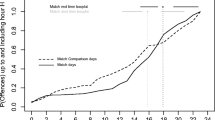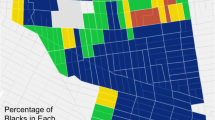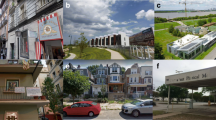Abstract
Urban renewal was one of several processes that contributed to deurbanization of American cities in the second half of the 20th century. Urban renewal was an important federal policy that affected thousands of communities in hundreds of cities. Urban renewal was to achieve “clearance” of “blight” and “slum” areas so that they could be rebuit for new uses other than housing the poor. Urban renewal programs fell disproportionately on African American communities, leading to the slogan “Urban renewal is Negro removal.” The short-term consequences were dire, including loss of money, loss of social organization, and psychological trauma. The long-term consequences flow from the social paralysis of dispossession, most important, a collapse of political action. This has important implications for the well-being of African Americans. It also raises important questions about the strength and quality of American democracy.
Similar content being viewed by others
References
Wallace R. Synergism of plagues: “planned shrinkage,” contagious housing destruction, and AIDS in the Bronx. Environ Res. 1988;47:1–33.
Lewis LL. When Harlem Was in Vogue. New York: Oxford University Press; 1981.
Gottlieb P. Making Their Own Way: Southern Blacks’ Migration to Pittsburgh, 1916–30. Urbana: University of Illinois Press; 1997.
Drake StC, Cayton HR. Black Metropolis: a Study of Negro Life in a Northern City. Vol 2. New York: Harcourt, Brace, and World; 1971.
Watkins BX. Fantasy, Decay, Abandonment, Defeat and Disease: Community Disintegration in Central Harlem 1960–1990 [dissertation]. New York: Columbia University; 2000.
Bracey JH, Meier A, Rudwick E, eds. The Rise of the Ghetto. Belmont, CA: Wadsworth Publishing Co; 1971.
Ernst RT, Hugg L. Black America: Geographic Perspectives. New York: Anchor Books; 1976.
Fullilove MT. House of Joshua: Meditations on Family and Place. Lincoln: University of Nebraska Press; 1999.
Bellush J, Hausknecht M. Urban renewal: an historical overview. In: Bellush J, Hausknecht M, eds. Urban Renewal: People, Politics and Planning. Garden City, NY: Anchor Books; 1967:3–16.
Jacobs J. The Death and Life of Great American Cities. New York: Random House; 1961.
Parin C, Jacobs J. L’Invitée. Urbanisme. September–October, 1999;308:16–25.
Bellush J, Hausknecht M. Relocation and managed mobility. In: Bellush J, Hausknecht M, eds. Urban Renewal: People, Politics and Planning. Garden City, NY: Anchor Books; 1967:366–377.
Thomas JM. Redevelopment and Race: Planning a Finer City in Postwar Detroit. Baltimore, MD: Johns Hopkins University Press; 1997.
Fried M. Grieving for a lost home. In: Duhl LJ, ed. The Urban Condition: People and Policy in the Metropolis. New York: Basic Books; 1963:151–171.
Link BG, Phelan J. Social conditions as fundamental causes of disease. J. Health Soc Behav. 1995;spec no:80-94.
Bishop M. Street by street, block by block. Roanoke Times and World-News. January 29, 1995;special supplement.
Saunders JR, Shackelford RN. Urban Renewal and the End of Black Culture in Charlottesville, Virginia: an Oral History of Vinegar Hill. Jefferson, NC: McFarland and Co; 1998.
Fainstein NI, Fainstein SS. New Haven: the limits of the local state. In: Fainstein SS, Fainstein NI, Hill RC, et al. eds. Restructuring the City: the Political Economy of Urban Redevelopment. New York: Longman Inc; 1983:27–79.
Fainstein SS, Fainstein NI, Armistead PJ. San Francisco: urban transformation and the local state. In: Fainstein SS, Fainstein NI, Hill RC, et al., eds. Restructuring the City: The Political Economy of Urban Redevelopment. New York: Longman Inc; 1983:202–244.
Robins A, ed. HillScapes: Envisioning a Healthy Urban Habitat. Pittsburgh, PA: The Maurice Falk Medical Fund, University of Pittsburgh; 1999.
Shipp SC. Winning some battles, but losing the war. Blacks and urban renewal in Greensboro, North Carolina 1953–1965. In: Thomas JM, Ritzdorf M, eds. Urban Planning and the African American Community: in the Shadows. Thousand Oaks, CA: Sage Publications; 1997:187–200.
Wallace AFC, Mazeway disintegration: human perception of socio-cultural disorganization. Hum Organ. 1957;16:23–27.
McKenzie RD. The ecological approach to the study of human community. In: Short JF Jr, ed. The Social Fabric of the Metropolis. Chicago: University of Chicago Press; 1971: 17–32.
Wishart J. An Unspeakable Sadness: the Dispossession of Nebraska Indians. Lincoln: University of Nebraska Press; 1994.
Author information
Authors and Affiliations
Corresponding author
Rights and permissions
About this article
Cite this article
Fullilove, M.T. Root shock: The consequences of African American dispossession. J Urban Health 78, 72–80 (2001). https://doi.org/10.1093/jurban/78.1.72
Issue Date:
DOI: https://doi.org/10.1093/jurban/78.1.72




